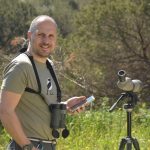
I’m certain many birders would agree with me on the fact that the imposed self-isolation and social distancing requirements suit us just fine. Long walks far away from large crowds? Ears filled with birdsong and no industrial hum? Sign me up! Going birding is even more of a no-brainer now than before.
A few days ago, we decided to check on a pair of nesting Short-tailed Hawks that were reported close to a busy roadway. Many moons ago, when I used to work in the (supposedly) booming petrochemical industry in Trinidad, most of my time was actually spent birding. I racked up a staggering number of life birds in the surprisingly rich surroundings during my four-odd years slaving for The Man.
In fact, if I remember correctly, it was 2013 when I first noticed (from an office window) a huge collection of sticks at the crown of a large immortelle tree. The dry season had begun and the tree was in a state of defoliation, drawing my attention to the alien mass at the top. If it was any indication of where my passion lay, instead of racing home like the proverbial bat out of hell, I stayed put to monitor this supposed nest. I was thrilled to see a Short-tailed Hawk fly in. Although relatively common here they’re notoriously difficult to see well – a phenomenon clearly not unique to this species!
When I heard of the pair nesting, I couldn’t help but wonder if it was the same pair. We arrived at dawn, thick clouds on the eastern horizon occluded any chance of magical golden light but as it was seven years ago, a raptor nest at the top of a defoliated tree needed no beacon.
The female Short-tailed Hawk at the nest stood calmly and quietly, casting occasional glances here and there. We remained inside our vehicle as ethical observation always is our first priority. Suddenly, she began to vocalize in every direction. It was only when I looked at my photos on the back of my camera I realized why. The little one was awake, and clearly hungry.

After about five minutes, her mate showed up on an adjacent tree. Her vocalizations did not cease. Clearly, he came back home with empty talons. She eventually flew closer to him, never ceasing in her vocal barrage.

Male (top) and female (below)
We decided to leave the couple to sort their differences out in privacy and head into some nearby cocoa estates to see what was on offer. Before we got to our destination, I pulled the car over to investigate an almost deafening twittering. To our delight, several hundred Dickcissels were busy feeding in a dry, scorched bamboo grove. These irruptive visitors to T&T always are a pleasure to experience.

Once we arrived at a suitable (i.e. birdy) spot, I attempted to have breakfast but clearly hadn’t thought it through properly. Before I had even cut the engine I caught a White-bearded Manakin staring. Violaceous Euphonias, Bay-headed Tanagers and Bananaquits fed on berries overhead. A pair of Streak-headed Woodcreepers called to each other in the distance. A Lineated Woodpecker banged its head against a dry branch. In this moment, I realized that it was indeed business as usual for everyone.

Bay-headed Tanagers

Turquoise Tanager

Violaceous Euphonias (yes there’s more than one bird here)

Golden-crowned Warbler is one of the three resident warbler species on Trinidad.
I managed to get my breakfast down eventually, after which we moved further into the forest. For those of you who are wondering why I’m talking about self-isolation and using “we”; my party consists of myself and my wife – who insists she is definitely not a birder. Having seen upwards of 600 species and knowing enough to respond swiftly to my request to find a calling Long-billed Gnatwren nearby with a sharp “No.” – I beg to differ.
We came upon another area abuzz with activity, Streaked and Boat-billed Flycatchers were very active as well as an eye-level Rufous-browed Peppershrike. This extremely vocal member of the vireo family utters its rich warble incessantly from sun-up to sun-down but it rarely makes itself visible. Naturally, as soon as I reached for my camera, it vanished.

I only found the Rufous-browed Peppershrike when it moved much further (and higher).
A female American Redstart showed up, but all attention was quickly diverted to a group of Channel-billed Toucans that had just arrived. We counted seven of these alluring birds while I killed my camera battery.

By the time my camera battery had went to 0%, the tropical sun was already heating things up and we were just about to pack up and leave when the flock of toucans flew toward us, one landing a mere 30 feet away.
Before we knew it, we were surrounded by flashes of yellow, red and white. Their shrill calls still echo in my ear. A reminder that nature does not find a way, it is the way.













Leave a Comment